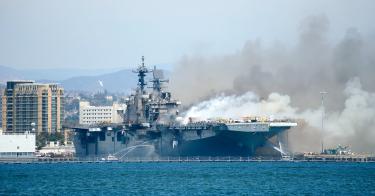On July 12, an explosion rocked the USS Bonhomme Richard, touching off a fire that raged for four days, gutting the amphibious assault ship. It was a catastrophe, but one the Navy may be able to turn to its advantage.
Replacing the ship would cost the Navy billions. But for less money, it could repurpose the Bonhomme Richard, making it an operational testbed for cutting-edge unmanned, sea-based weapons systems. This would help the Navy address concerns about unmanned systems and improve the prospect of growing the fleet—in both size and lethality—more rapidly.
For now, however, the ship’s future remains in question. It has sustained damage so extensive, it’s not known if it can ever sail again.
For a Navy that is struggling to meet its mandated fleet of 355 ships, loss of the Bonhomme Richard would be a significant setback. With tensions sharpening in the South China Sea and Russian provocations on the rise, the ship’s capacity to conduct a wide variety of maritime operations is especially valuable at this juncture.
Navy investigators are sifting through evidence to ascertain what caused the explosion and why the fire was so intense and engineers will review the ship’s design—all in an effort to prevent a repeat. Much has already been written about what these reviews may reveal, how the incident will affect deployment schedules and the importance of improving the Navy’s readiness.
These are all very important issues. However, with the Defense Department currently rethinking how it wants to structure the future Navy, this fire provides something else: an opportunity.
Congress has made clear that it is uneasy with expanding investment in unproven unmanned systems. Both House and Senate versions of the new National Defense Authorization Act condition the procurement of naval unmanned platforms on the Pentagon first certifying their reliability. Additionally, there is as yet no clear articulation of how unmanned systems would augment and count in the future fleet—a question that the Navy’s recently established Surface Development Squadron One is intended to address—at least with regards to surface manned and unmanned vessels.
A reconstituted Bonhomme Richard with the explicit mission of deploying and sustaining an armada of unmanned platforms would help advance the Pentagon’s thinking about such systems. Experimentation could: explore how to simultaneously control multiple unmanned vessels on, below and above the sea; develop the concepts of how to coordinate unmanned operations with those of manned ships and aircraft; and refine the requirements for maintaining unmanned platforms at sea.
While the damage assessments for the Bonhomme Richard are ongoing, it has been reported the engineering spaces suffered no major damage—a bit of good news. Assuming the ship can be returned to sea, its flight deck launching and retrieving aerial platforms, the well deck for embarking small boats and submersibles, and its C2 (command and control) capacity makes it uniquely well-suited to field test and certify a range of maritime unmanned platforms. Just as critical, the experience gained would greatly inform the training and specialization of Navy technicians and operators for a burgeoning unmanned fleet.
Moreover, at over 40,000 tons, the ship would be large enough to periodically host combined and joint experimentation with allies as well as other services. This would be fully in keeping with the National Defense Strategy’s emphasis improving jointness with our allies. And experimentation with other U.S. services can accelerate the development of joint operations able to confront Chinese and Russian anti-access and anti-denial (A2/AD) threats.
Perhaps the Bonhomme Richard can be cost-effectively restored to operational fitness as an amphibious assault ship. But if not, decommissioning is not the only option. Consideration should be given to repurposing it as a test platform. The USS Langley’s fleet experimentation helped develop the war-winning carrier fleet of World War II. The Bonhomme Richard can serve a similar purpose for unmanned platforms.
Hopefully, the Bonhomme Richard can be returned to sea, and soon. If it can’t rejoin the operational fleet, the Navy would be wise to use this opportunity to advance critical new unmanned capabilities that will undoubtedly figure prominently in any future conflict.
This piece originally appeared in The Washington Times




